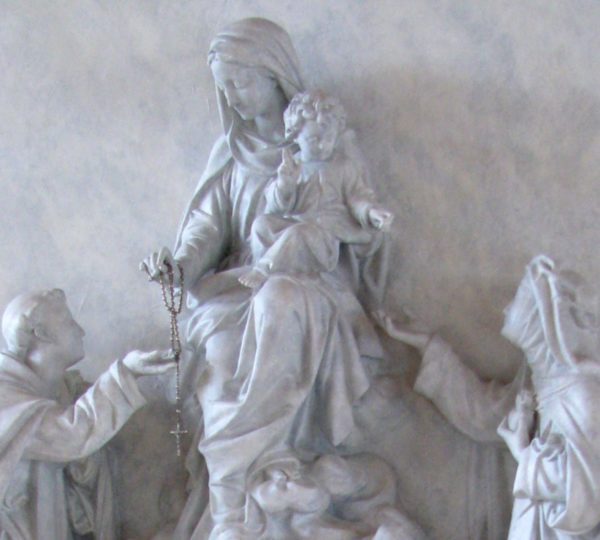
When I began to prepare these reflections for today’s Feast of the Holy Rosary, a memory popped up before me, one that many here may share – the memory of saying the family rosary – kneeling in front of our couch with the framed Sacred Heart picture on the wall above us. I don’t remember how often we did this, but I do recall that as the youngest, I went last in the order of leading the prayer and that I spent most of the time worried that I would lose my place and not know what to say when it was my turn. And I also remember the plastic statue of Our Lady with the bottom that was unscrewed for the storage of the huge rosary.
Each year, October 7 is a day set aside when we gather to celebrate the Solemnity of the Feast of Our Lady of the Rosary. This feast has been special for us since the very beginning of our Congregation, and with significance going even further in the history of the Dominican Order, back to Dominic himself.
Each of us has a personal history with the Rosary. I would venture to believe that those of us present, who entered the Dominican Congregation of Our Lady of the Rosary, were mostly unaware of the history of that title. Yet, that history has always journeyed with us as vowed members and Associates.
In the mysteries of the rosary, we meet and reflect on key moments in the life of Jesus, Mary, and his followers. But these mysteries are also played out in our world, in our Church, and in our personal and communal lives. I believe that today’s readings offer a way to journey with the mysteries in our time.
In today’s Gospel, we read that Mary is visited by an angel messenger. She listens, asks for clarification, for the message seems impossible, and accepts with trust that the way forward will be revealed. She then moves out from her own concerns to go to her cousin, Elizabeth.
Listen, Pray, Trust, Act
The First Reading for today recounts the days between the Ascension and Pentecost. The Apostles returned to Jerusalem as Jesus had directed them to do, gathered in the upper room, and devoted themselves with one accord (in harmony) to prayer. We are told that Mary and some other women and Jesus’ brothers were with them. I can imagine that Mary’s presence in that Jerusalem room was a comfort to the Apostles and perhaps they were a comfort to her as they shared their memories of Jesus – still so fresh. They listened to each other as they waited for the Holy Spirit, the Comforter, to be upon them. They then go out to an unknown future.
Listen, Pray, Trust, Act
The journey between these two Scripture accounts is a long one for Mary. The journey of Mary, the teenager being told she will carry a child and name him Jesus – to Mary, the woman in the upper room nearing the age of 50, I imagine. We don’t meet Mary often in the Scriptures but when we do, she is no wilting flower. We find her when:
- She speaks to Jesus at Cana, which results in his first public miracle.
- She goes to look for him with his brothers and when she finds him, she hears a difficult and puzzling message “Who is my mother and my brothers?”
- She waits with the other women at the foot of the cross.
- She receives her dead son’s body.
- She is in the upper room waiting in prayer with the Apostles before Pentecost.
Mary lived the mysteries of the Rosary in her life as she journeyed with her son and had to trust in an unseen way forward. So too with us, each with our own unique experiences. We contemplate the events in Jesus’ life and in our own lives. We live the joys, the sorrows, the glorious moments, the luminous moments of clarity.
This week, Pope Francis opened the long-prepared-for sessions in Rome of the Synod on Synodality. He had asked that before the opening, the members attend a three-day retreat led by Dominican priest and past Master General of the Order, Timothy Radcliffe. His first talk of the retreat was titled, “Hope Against Hope.”
In his reflections, Timothy spoke of “Eucharistic generosity.” He recalled that Jesus, on the night before he died, when all seemed a failure, made the most hopeful gesture saying, “This is my body, given for you. This is my blood, poured out for you.” Jesus gave himself to his Apostles. Timothy called for the members of the Synod to not merely share words and convictions, but to share themselves, with Eucharistic generosity, so they might open themselves to listen to the Spirit and let go of fear.
Pope Francis, in his address on the opening day of the Synod, pointed out to those gathered that the priority of their time together was to listen.
How do we act out of Eucharistic generosity in our own lives and in our world? We first listen to the God within and who comes to us through others. Then, we trust the way forward and we act. Whether on a picket line, writing or calling members of Congress, whether as aides or nurses in Siena Hall who offer our hands in the care of others, or those who receive the care pointing out the goodness of those who serve, we can all give of ourselves to others in Eucharistic generosity.
We live in a complex and often frightening time in our world, our country, our communities, our personal lives. Two days ago, the Nobel Prize for Peace was awarded to Narges Mohammadi, an Iranian woman, for her fight against the oppression of women in Iran and her work to promote human rights and freedom for all. Narges is in prison in Iran. She is serving a 10-year sentence for not wearing a veil and for attending a memorial for an activist who was killed. She received 154 lashes with a whip. She has not seen her twin children in eight years. They are in exile in France with her husband who in the past was also jailed for 14 years for his human rights work. Still, Narges speaks out from prison with her actions on behalf of the voiceless, “This is my body given for you; this is my blood poured out for you.” She is a light and expression of Eucharistic generosity.
Awarding Narges the Nobel Prize for Peace is also a sign of hope. We can’t lose sight of the fact that the prize symbolically takes her out of prison and puts her sacrifice and goodness in front of the whole world. What will come of her sacrifice is unknown, but recalling the words of Timothy Radcliffe, we “hope against hope” for peace and justice.
The journey from the founding of our Congregation and its dedication to Our Lady of the Rosary is long, but in its essence, stays the same. We have listened to the Divine voice within our hearts; paused in prayer; trusted in an unseen way forward, and acted to bring hope and peace into our world as our God transforms us like Mary into courageous disciples embracing a radical living of the Gospel.
Today, we also celebrate three of our Associate members as they journey with us and renew their commitment. We thank God for the generous response of faith of Mary Ryan, Ann Hagopian, and Jim Russell. They have listened, prayed, trusted, and acted.
They are gifts, and not only do they serve with us, but they are an example of entering with trust into a yet unseen future, together.
 – Aileen Donovan, OP
– Aileen Donovan, OP
Sister Aileen currently serves on the Leadership Team. Prior to this appointment she was the Executive Director of Marian Woods, an inter-congregational residence for senior members of women’s religious communities.
